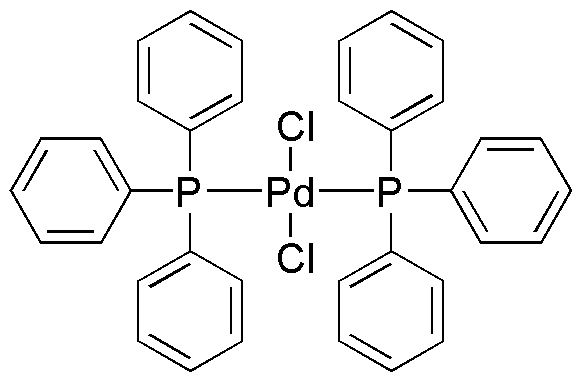Bis(triphenylphosphine) palladium(II) dichloride is widely utilized in research focused on:
- Catalysis: This compound serves as a highly effective catalyst in cross-coupling reactions, such as Suzuki and Heck reactions, which are essential for synthesizing complex organic molecules in pharmaceuticals and agrochemicals.
- Organic Synthesis: It plays a crucial role in the development of new materials and fine chemicals, enabling researchers to create innovative compounds with specific properties for various applications.
- Nanotechnology: The compound is used in the preparation of palladium nanoparticles, which have applications in electronics, sensors, and catalysis, providing enhanced performance compared to bulk materials.
- Pharmaceutical Development: Its ability to facilitate the formation of carbon-carbon bonds makes it invaluable in drug discovery, allowing for the efficient synthesis of bioactive molecules.
- Environmental Chemistry: The compound is also explored for its potential in environmental remediation processes, such as the degradation of pollutants, showcasing its versatility beyond traditional applications.
General Information
Properties
Safety and Regulations
Applications
Bis(triphenylphosphine) palladium(II) dichloride is widely utilized in research focused on:
- Catalysis: This compound serves as a highly effective catalyst in cross-coupling reactions, such as Suzuki and Heck reactions, which are essential for synthesizing complex organic molecules in pharmaceuticals and agrochemicals.
- Organic Synthesis: It plays a crucial role in the development of new materials and fine chemicals, enabling researchers to create innovative compounds with specific properties for various applications.
- Nanotechnology: The compound is used in the preparation of palladium nanoparticles, which have applications in electronics, sensors, and catalysis, providing enhanced performance compared to bulk materials.
- Pharmaceutical Development: Its ability to facilitate the formation of carbon-carbon bonds makes it invaluable in drug discovery, allowing for the efficient synthesis of bioactive molecules.
- Environmental Chemistry: The compound is also explored for its potential in environmental remediation processes, such as the degradation of pollutants, showcasing its versatility beyond traditional applications.
Documents
Safety Data Sheets (SDS)
The SDS provides comprehensive safety information on handling, storage, and disposal of the product.
Product Specification (PS)
The PS provides a comprehensive breakdown of the product’s properties, including chemical composition, physical state, purity, and storage requirements. It also details acceptable quality ranges and the product's intended applications.
Certificates of Analysis (COA)
Search for Certificates of Analysis (COA) by entering the products Lot Number. Lot and Batch Numbers can be found on a product’s label following the words ‘Lot’ or ‘Batch’.
Numéro de catalogue
Numéro de lot/série
Certificates Of Origin (COO)
This COO confirms the country where the product was manufactured, and also details the materials and components used in it and whether it is derived from natural, synthetic, or other specific sources. This certificate may be required for customs, trade, and regulatory compliance.
Numéro de catalogue
Numéro de lot/série
Safety Data Sheets (SDS)
The SDS provides comprehensive safety information on handling, storage, and disposal of the product.
DownloadProduct Specification (PS)
The PS provides a comprehensive breakdown of the product’s properties, including chemical composition, physical state, purity, and storage requirements. It also details acceptable quality ranges and the product's intended applications.
DownloadCertificates of Analysis (COA)
Search for Certificates of Analysis (COA) by entering the products Lot Number. Lot and Batch Numbers can be found on a product’s label following the words ‘Lot’ or ‘Batch’.
Numéro de catalogue
Numéro de lot/série
Certificates Of Origin (COO)
This COO confirms the country where the product was manufactured, and also details the materials and components used in it and whether it is derived from natural, synthetic, or other specific sources. This certificate may be required for customs, trade, and regulatory compliance.


